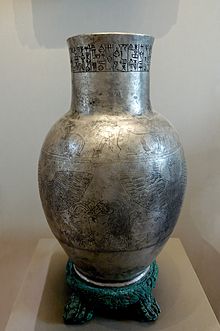Vase of Entemena

The Vase of Enmetena is a tripod type silver vase and was named after Enmetena, the ruler of Lagash.[1]
The vase was recovered in Telloh in 1888 at the site of ancient Shirpurla by Ernest de Sarzec.[2] It was donated to the Louvre by Sultan Abdul Hamid II in 1896 and was thought to be one of the oldest surviving examples of engraving on metal.[3][4]
This vase is believed to date back to c. 2400 BCE.[5] The vase is believed to be dedicated to the war god Ningirsu.[6]
The legs of the vase are made of copper.[7] On the surface of the vase lightly engraved, is an image of Anzud the lion-headed eagle, grasping two lions with his talons.
Enmetena was a Sumerian king who reigned for 27 years.[citation needed]
In 1910, Leonard William King described this vase as "the finest example of Sumerian metal work yet recovered."[8]
See also
References
- ^ Deutsche Morgenländische Gesellschaft (1968). Zeitschrift der Deutschen Morgenländischen Gesellschaft (in German). Kommissionsverlag F. Steiner. p. 358. Retrieved 20 September 2018.
- ^ Huh, S.K. (2008). Studien zur Region Lagaš von der Ubaid- bis zur altbabylonischen Zeit. Alter Orient und Altes Testament (in German). Ugarit-Verlag. p. 97. ISBN 978-3-86835-003-6. Retrieved 20 September 2018.
- ^ The Encyclopaedia Britannica: A Dictionary of Arts, Sciences, Literature and General Information. The Encyclopaedia Britannica: A Dictionary of Arts, Sciences, Literature and General Information. University Press. 1910. p. 108. Retrieved 20 September 2018.
... No remarkable specimens of the metallurgic art of an early period have been found, apart perhaps from the silver vase of Entemena ...
- ^ Frothingham, A. L. (1896). "Archæological News". The American Journal of Archaeology and of the History of the Fine Arts. 11 (3): 499. JSTOR 496506.
- ^ Alcouffee, D.; Musée du Louvre; Réunion des musées nationaux (France) (1991). Louvre: guide to the collections. Réunion des musées nationaux. p. 41. ISBN 978-2-7118-2489-2. Retrieved 20 September 2018.
Vase of Entemena Prince of Lagash Tello, formerly Girsu Around 2400 HC Silver and Copper. H 0.35 m; W 0.18 m E de Sarzec Excavations.
- ^ Bertman, S. (2005). Handbook to Life in Ancient Mesopotamia. Facts on File Library of world history. OUP USA. p. 84. ISBN 978-0-19-518364-1. Retrieved 20 September 2018.
- ^ Buckingham, J.S.; Sterling, J.; Maurice, F.D.; Stebbing, H.; Dilke, C.W.; Hervey, T.K.; Dixon, W.H.; Maccoll, N.; Murry, J.M.; Rendall, V.H. (1897). The Athenaeum: A Journal of Literature, Science, the Fine Arts, Music, and the Drama. J. Francis. pp. 893 ff. Retrieved 20 September 2018.
.... Let me notice in this series the silver vase of the patesi Entemena, mounted on four feet of copper, and decorated by zones of ...
- ^ Leonard W. King (1994) [1910]. A History of Sumer and Akkad. Ripol Classic. pp. 167–169. ISBN 9785876640345. OCLC 1064218.
